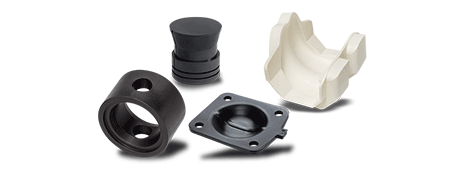Manufacture of multi-component parts
Intercarat manufactures composite parts made of elastomer/plastic as well as rubber/metal and PTFE/metal.
An asset for numerous applications
Multi-component parts can provide cost advantages and are therefore being used in an increasing number of industries. In addition, individual parts of an assembly unit or another assembly type can certainly be combined in a multi-component part. This reduces the number of individual components, simplifies handling and minimises potential installation time and costs.
Manufacturing processes
- CM procedure (compression moulding procedure)
- IM procedure (overmoulding of plastic/metal cores for special requirements)
Our material combinations
- Rubber/plastic combinations (PEEK, PA, PTFE; 0.4 to 3 mm thick)
- Rubber/metal combinations (milled and turned parts made of stainless steel, steel and nonferrous metal in a range of different grades, as well as diecast parts (aluminium, zinc) with diameters up to 400 mm
- Plastic/metal combinations (PTFE 0.4 to 3 mm thick; metal and rubber/metal)
We also manufacture customised rubber/metal/plastic combinations in-house.
High-quality composite system
We manufacture composite parts under vacuum conditions to avoid trapped air and air bubbles. Furthermore, we have many years of experience in creating chemical compounds using suitable substances, while the moulding process ensures the mechanical connection of the materials. The excellent chemical and mechanical properties of our products continue to impress our customers. Needless to say, we ensure that all materials and processes used comply with industry-specific standards and directives (e.g. ACS, WRAS, DVGW, FDA).
Creating compounds using film lamination
Another manufacturing technology used at Intercarat is lamination. In this case, several layers are combined with purely chemical additives or we lay a film coating on the polymer. The focus here is on the manufacture of diaphragms using the material EPDM and the thermoplastic material PTFE. This makes the composite part more resistant to chemicals, acids and alkalis. Generally, however, this process can also be used for other types of rubber.
Impressive surface technology
Multi-component parts can also be manufactured and provided with various surface finishes. An example of this is the application of a bonding agent in an in-house varnishing booth.

